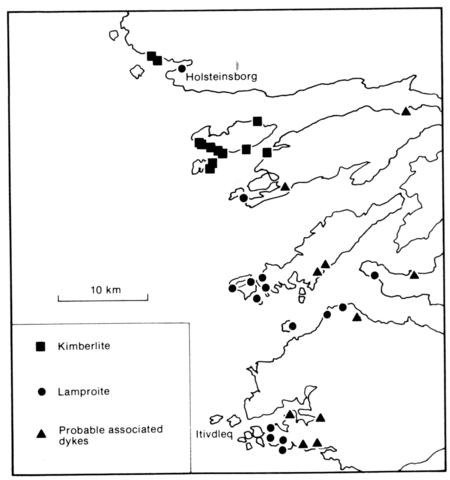stripes
Lamproite and kimberlite dykes occur along the West Greenland coast between Holsteinsborg and Itivdleq cutting early rocks of the Proterozoic Nagssugtoqidian mobile belt. Scott (1981, Fig. 1) also indicates the presence of further dykes some 70 km to the southeast, but these may be associated with the Sarfartoq carbonatite centre (063-00-027). The dykes trend east-west and may be followed for up to 2 km. The kimberlites vary from a few cm to 2 m in width; the lamproites are less than 1 m, sometimes zoned, and often intruded en echelon. The wider kimberlite dykes sometimes have a central zone choked with ultrabasic inclusions, whereas the only inclusions found in the lamproites are angular country rock xenoliths with minor reaction rims. The kimberlites consist of abundant olivine and phlogopite, clinopyroxene, picroilmenite, chrome spinel, perovskite, carbonate, serpentine and apatite. The lamproite dykes are mineralogically very variable: Ti-rich phlogopite is ubiquitous and pseudoleucite and olivine (Fo93-87) are usually important constituents; these phases together with Cr-bearing diopside may form phenocrysts. Other minerals found in the groundmass include potassic richterite, K-feldspar, carbonate and accessories, including priderite. Analyses of minerals and rocks and discussion of the geochemistry will be found in Scott (1979 and 1981).
BROOKS, C.K., NOE-NYGAARD, A., REX, D.C. and RANSBO, J.G. 1978. An occurrence of ultrapotassic dikes in the neighbourhood of Holsteinsborg, West Greenland. Bulletin of the Geological Society of Denmark, 27: 1-8.
SCOTT, B.H. 1979. Petrogenesis of kimberlites and associated potassic lamprophyres from central West Greenland. Proceedings of the Second International Kimberlite Conference. American Geophysical Union, Washington, 1: 190-205.
SCOTT, B.H. 1981. Kimberlite and lamproite dykes from Holsteinsborg, West Greenland. Meddelelser om Gronland, Geoscience, 4: 1-24.

